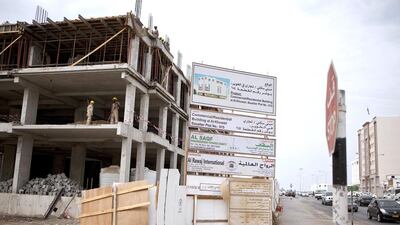The cost of building projects in Oman is expected to increase next year after the government said it would double gas prices for cement manufacturers.
Oman’s two largest cement companies, Oman Cement and Raysut Cement, reported yesterday that they would be revising prices for cement because of the government’s decision to withdraw gas subsidies from January 1.
The move comes as global oil prices continue to weaken, reducing the amount of cash the government has available to provide support to businesses.
The companies said that Oman’s ministry of oil & gas planned to increase prices for cement manufacturers from US$1.50 per million British thermal units to US$3.
Oman Cement reported that its costs would go up by about 6.63 million rials (Dh63m) in 2015, while Raysut said that its gas costs would increase by 4.5m rials next year.
“The company will make efforts to minimise the impact of this increase on its profits by improved productivity, cost control and restructured pricing,” Jamal Shamis Al Hooti, the chief executive of Oman Cement said in a bourse statement yesterday. “We have made a representation to the government in this regard for a reconsideration of the decision.”
The news comes as the ratings agency Standard & Poor’s downgraded its outlook for the country from “stable” to “negative” because of the recent fall in the oil price.
Oil accounted for just less than half of the country’s GDP last year. Now Omani crude oil is forecast to average about $80 a barrel over the next two years, down substantially from S&P’s previous assumption of $95 a barrel.
The Muscat Securities Market general index fell 4.2 per cent in trading yesterday on the back of the S&P downgrade and gas price increase.
Raysut Cement fell 9.9 per cent to 1.7 rials, while Oman Cement slid 9.8 per cent, its biggest fall since May 2000, to close at 0.57 rials.
“We expect that the effect of this move will be that costs will be passed on to contractors and developers,” said Chris Seymour, a partner and head of property at EC Harris. “We don’t yet have visibility on how much that is going to be. At the moment we still think that any increase will be within the inflation allowances we factor into construction estimates. But there are a number of complicating factors when measuring how much exactly costs will increase.
“There is still capacity in the UAE for further cement manufacture where subsidies look set to stay in place,” Mr Seymour added. “So it seems likely that if prices for cement in Oman increase then developers and contractors could import more from the UAE.
“Currently the UAE exports 11 million tonnes of cement a year and uses another 11 million tonnes. However, there are also costs associated with importing concrete which companies would have to weigh up.”
Last year the Omani government announced that it would spend more than $500 billion on infrastructure projects over the next 15 years with $20bn earmarked for the transport sector.
lbarnard@thenational.ae
Follow The National's Business section on Twitter

